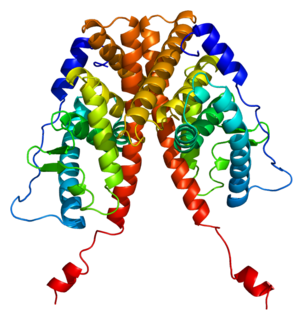Breast carcinoma amplified sequence 3, also known as BCAS3, is a protein which in humans is encoded by the BCAS3 gene. [5] [6] BCAS3 is a gene that is amplified and overexpressed in breast cancer cells. [6]
Breast carcinoma amplified sequence 3, also known as BCAS3, is a protein which in humans is encoded by the BCAS3 gene. [5] [6] BCAS3 is a gene that is amplified and overexpressed in breast cancer cells. [6]
The BCAS3 gene is regulated by estrogen receptor alpha (ER-α). [7] The PELP1 protein acts as a transcriptional coactivator of estrogen receptor induced BCAS3 gene expression. In addition BCAS3 possesses histone acetyltransferase activity and itself appears to act as a coactivator of ER-α. [8] Furthermore, BCAS3 requires PELP1 to function as a coactivator in ER-α. Hence BCAS3 apparently is involved in a positive feedback loop leading to ER-α mediated signal amplification. [8]

Estrogen receptors (ERs) are a group of proteins found inside cells. They are receptors that are activated by the hormone estrogen (17β-estradiol). Two classes of ER exist: nuclear estrogen receptors, which are members of the nuclear receptor family of intracellular receptors, and membrane estrogen receptors (mERs), which are mostly G protein-coupled receptors. This article refers to the former (ER).

Proline-, glutamic acid- and leucine-rich protein 1 (PELP1) also known as modulator of non-genomic activity of estrogen receptor (MNAR) and transcription factor HMX3 is a protein that in humans is encoded by the PELP1 gene. is a transcriptional corepressor for nuclear receptors such as glucocorticoid receptors and a coactivator for estrogen receptors.
In molecular biology and genetics, transcription coregulators are proteins that interact with transcription factors to either activate or repress the transcription of specific genes. Transcription coregulators that activate gene transcription are referred to as coactivators while those that repress are known as corepressors. The mechanism of action of transcription coregulators is to modify chromatin structure and thereby make the associated DNA more or less accessible to transcription. In humans several dozen to several hundred coregulators are known, depending on the level of confidence with which the characterisation of a protein as a coregulator can be made. One class of transcription coregulators modifies chromatin structure through covalent modification of histones. A second ATP dependent class modifies the conformation of chromatin.

Estrogen receptor alpha (ERα), also known as NR3A1, is one of two main types of estrogen receptor, a nuclear receptor that is activated by the sex hormone estrogen. In humans, ERα is encoded by the gene ESR1.

The nuclear receptor coactivator 3 also known as NCOA3 is a protein that, in humans, is encoded by the NCOA3 gene. NCOA3 is also frequently called 'amplified in breast 1' (AIB1), steroid receptor coactivator-3 (SRC-3), or thyroid hormone receptor activator molecule 1 (TRAM-1).

AKT2, also known as RAC-beta serine/threonine-protein kinase, is an enzyme that in humans is encoded by the AKT2 gene. It influences metabolite storage as part of the insulin signal transduction pathway.

Metastasis-associated protein MTA1 is a protein that in humans is encoded by the MTA1 gene. MTA1 is the founding member of the MTA family of genes. MTA1 is primarily localized in the nucleus but also found to be distributed in the extra-nuclear compartments. MTA1 is a component of several chromatin remodeling complexes including the nucleosome remodeling and deacetylation complex (NuRD). MTA1 regulates gene expression by functioning as a coregulator to integrate DNA-interacting factors to gene activity. MTA1 participates in physiological functions in the normal and cancer cells. MTA1 is one of the most upregulated proteins in human cancer and associates with cancer progression, aggressive phenotypes, and poor prognosis of cancer patients.

Mediator of RNA polymerase II transcription subunit 1 also known as DRIP205 or Trap220 is a subunit of the Mediator complex and is a protein that in humans is encoded by the MED1 gene. MED1 functions as a nuclear receptor coactivator.

Probable ATP-dependent RNA helicase DDX5 also known as DEAD box protein 5 or RNA helicase p68 is an enzyme that in humans is encoded by the DDX5 gene.

Nuclear receptor coactivator 6 is a protein that in humans is encoded by the NCOA6 gene.

Cyclin-C is a protein that in humans is encoded by the CCNC gene.

Mediator of RNA polymerase II transcription subunit 14 is an enzyme that in humans is encoded by the MED14 gene.

Tripartite motif-containing 24 (TRIM24) also known as transcriptional intermediary factor 1α (TIF1α) is a protein that, in humans, is encoded by the TRIM24 gene.

Breast cancer anti-estrogen resistance protein 3 is a protein that in humans is encoded by the BCAR3 gene.

Mediator of RNA polymerase II transcription subunit 17 is an enzyme that in humans is encoded by the MED17 gene.

Pre-mRNA-splicing factor SPF27 is a protein that in humans is encoded by the BCAS2 gene.

Breast carcinoma-amplified sequence 1 is a protein that in humans is encoded by the BCAS1 gene.

Mediator of RNA polymerase II transcription subunit 16 is an enzyme that in humans is encoded by the MED16 gene.

Zinc finger protein 366, also known as DC-SCRIPT, is a protein that in humans is encoded by the ZNF366 gene. The ZNF366 gene was first identified in a DNA comparison study between 85 kb of Fugu rubripes sequence containing 17 genes with its homologous loci in the human draft genome.

Proline-rich nuclear receptor coactivator 1 is a protein that, in humans, is encoded by the PNRC1 gene.